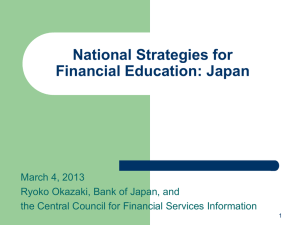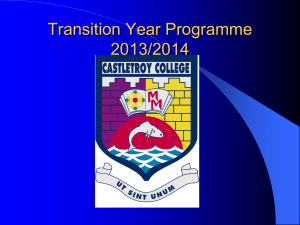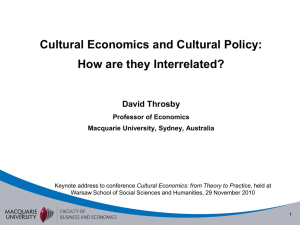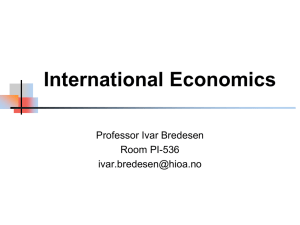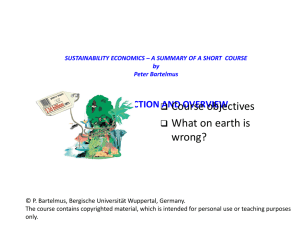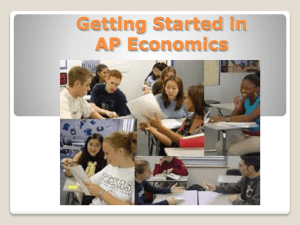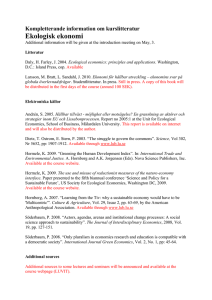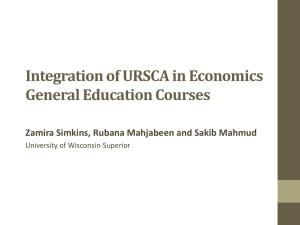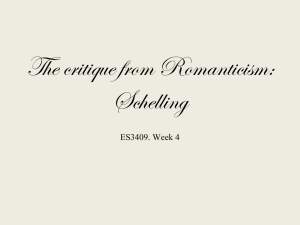Economics of Conflict and Peace
advertisement
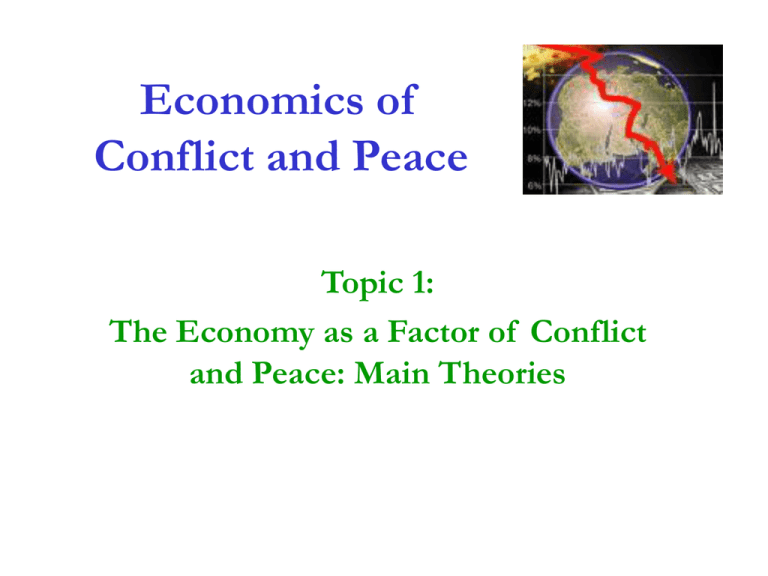
Economics of Conflict and Peace Topic 1: The Economy as a Factor of Conflict and Peace: Main Theories Economics and Conflict 1. 2. 3. 4. Conflict affects economic activities; Economic factors affect conflict; Conflict is a result of choice of economic agents; Conflict as an economic activity “The efforts of men are utilized in two different ways: they are directed to the production or transformation of economic goods, or else to the appropriation of goods produced by others” (Vilfredo Pareto) Topics in the Economic Analysis of Conflict 1. 2. 3. 4. Sources of conflict: Are certain form of organization more likely to bring about conflict? Does increasing wealth make conflict more or less likely? Equilibrium and comparative static: what are the determinants of equilibrium in a varying dimensions of conflict? When is repeated gamemodel applicable and how does it change solution? Is the wealthier side always at an advantage? When we consider that decision are made not by unitary individuals but by groups? Operation research and sources of conflict: trade-off: offense vs. defense, manpower vs. material; centralized vs. decentralized control; Conflict, economy and society: driving forces of conflict; role of conflict and threat of conflict in determining differential power and wealth of nations, of social classes, and individuals. How does conflict affect the internal structure of organizations? Conflict Theory and Exchange Theory 1. 2. 3. Conflict theory shares with exchange theory the central analytic paradigm of optimization on the individual level of analysis and societal equilibrium on the aggregate level. Preference functions, competitions, increasing and decreasing returns play comparable roles in both branches of economic theory; The key difference is that the societal interactions dealt with the exchange theory as a source of mutual advantage, whereas in conflict theory and advantage gained by one party must come at the expense of rivals; Any settlement or compromise arrived at, and even the process of exchange itself, takes place in the shadow of the potential conflict. Debates on peace, war and defense (Fanny Coulomb, 2004) I. National power benefits from the economy 1.1. The mercantilist movement (Mun, Davenant, Child, Bodin, Colbert, Furtado) • Mercantilist system was a system of power politics; • The ends of mercantilism were unification of the national state and development of its industrial, commercial, financial, military resources; • Pragmatic and nationalist doctrine; • War was inherent in the mercantilist system, economic life is mobilized for political purposes; • Static conception of international economic relations, the power of nation benefits from economic wealth; exports and imports were controlled, stocks of precious metals were conserved; colonies were settled and protected; • All considerations of national economy and individual welfare are subordinated to the single purpose of developing the potentialities of the nation to prepare for war and to wage war. I. National power benefits from the economy 1.2. ‘Contemporary’ debates on the power (Eli Heckscher, John Maynard Keynes, Joseph Schumpeter, Edmund Silberner) Main questions: 1) What is the objective of economy, power and wealth? 2) Is economic power necessarily a response to an economic situation of conflict? • Bellicose interpretation of mercantilism: search for autarky, the xenophobia, idealization of war (Edmund Silberner); • Mercantilism is aimed at the objective of the State’s power (Eli Heckscher, Mercantilism, 1931); • Mercantilist’s bellicosity was a realistic answer to the monetary problems of the time, John Maynard Keynes, General Theory (1936); • Mercantilist policy was based on the monopoly of exports and control of imports and exchange rates – rational explanation from the situation of conflict and international tensions of the time Joseph Schumpeter, History of Economic Analysis (1954) Friedrich List (1789-1846): the theory of security and national economy’s development • F. List is the first economist, who placed security in the center of economic analysis; security is explanatory element of the way State economy works and integrates into international economy; • Military issues are instruments for the geo-economic security; • The economy is beneficial to national strategic interests; • State intervention in trade policy is to ensure the development of national productive forces; • Unlike Adam Smith, F. List asserts defense expenditure allows to increase in national productive forces; • Power of production is the key of national security; • Economic patriotism: close relations between moral and economics forces; • Peace is a temporary suspension of conflicts in a world marked by the disparity in levels of national economic development The classical economists: free trade, a factor of peace and prosperity (Adam Smith, J.B. Say) • Uselessness of wars and their fundamentally extra economic character; • Change from an offensive to a defensive foreign policy; • The conception of an economic body naturally governed by an ‘invisible hand’; • Principle of an ‘apolitical’ economic analysis of war; • Industrial pacifism Conflict as state failure: liberal economic theories Adam Smith (1776): the State is a place of conflicts and the decision to make war, or peace, depends on political processes, the balance of power between the different social classes; universal peace was part of a law of nature. Man is naturally social and so war results from imperfections in human nature, in particular of ambition, and as such it can be only a temporary phenomenon. This theory directly inspired the liberal economic theories, which see the economy as governed by an “invisible hand”, a natural order in which the State should not intervene. The end of international conflicts thanks to the spread of civilization and free market economies. The costs of war are the destruction of resources, the interruption of trade and the burden of debt when war is financed by loans. Wars are counterproductive and cannot be justified by the benefits of predation and territorial expansion, since the surest way to increase the national economic growth is through the development of trade with prosperous neighbors. denial the legitimacy of wars, which are seen as resulting from a perversion of the political process, with the state undertaking military actions to serve particular interests Classical Political Economy and Class Struggle Two different types of social conflict in classical political economy: 1) Struggle of people (e.g. bourgeoisie, the working class and the peasants) against the feudal or aristocratic order; this type of struggle aimed at changing the whole political/social order; 2) Conflicts inside the bourgeois society regarding the distribution of wealth Neoclassical economics: peace as the norm (Leon Walras, Vilfredo Pareto, Alfred Marshall) Conflict disappeared from domain of economic science: Alfred Marshall’s definition of economics, Principles of economics, 1890:”… economics is the study of mankind in the ordinary business of life.” “Conflict” in the mainstream economic literature is typical of a rather benign form – the foregoing of a mutually advantageous exchange. Mainstream economics consider very special case of “pro-systemic” conflict: as an equilibrium phenomenon when the players have incomplete information about the preferences or strategies of other players. Decision to go to war is considered as irrational. Wars Occur Due to Misinformation and/or Irrationality: • war is very costly: it diverts resources to military production, destroys people and property, and disrupts economic activities; • whatever outcome arises from war, it could have been achieved without war at a much lower cost. Violent human conflict is not ordinary, thus conflict lies outside the domain of economics and tends to be ignored in mainstream economics textbooks, economists specializing in conflict are doing political science, not economics, hence, there are relatively few courses and fields in conflict economics in undergraduate programs. Strategic Conflict Theory (T. Schelling) • • • Principal subject of this theory is deterrence, not real war or social conflict; Theory tries to capture the ‘threat’ or ‘potential’ versus actual destruction in case of a limited war; Deterrence is regarded as if it consists of bargaining between rational, maximizing commercial agents (rationality assumption and maximizing behavior of agents); It is faithful to our definition of ‘strategy’: it takes conflict for granted, but also assumes a ‘rational’ value-maximizing mode of behavior; and it focuses on the fact that each participant’s best choice of action depends on what he expects the other to do, and that ‘strategic behavior’ is concerned with influencing another’s choice by working on his expectation of how one’s own behavior is related to his (Tomas Schelling, Strategy of Conflict, 1963) • • Conflict coexists with mutual dependence; Theory explores ‘variable-sum games’ instead of ‘constant-sum games’ On the strategy of pure conflict – the zero-sum-games – game theory has yielded important insight and advice. But on the strategy of action where conflict is mixed with mutual dependence – the nonzero-sum games involved in wars and threats of war, strikes, negotiations, criminal deterrence, class war, race war, price war, and blackmail . . . traditional game theory has not yielded comparable insight or advice. (Tomas Schelling, Strategy of Conflict, 1963) Real and rational conflict theories (systematization: Mehrad Vahabi, 2004) Conflict conditions and activity of violenceproducing organizations • • • • • • Conditions for violent conflict persist: Poverty →risk of civil conflict →more poverty; Ethnic dominance →risk of civil conflict →more ethnic hatreds; Corruption →new discovery of resources (e.g., oil) →more corruption; Habituation to conflict and insecurity →static and zero-sum views of economics predominate →peace is undervalued; Distrust and security dilemmas worsen following reneged peace deals →high settlement costs and commitment problems →conflict endures; Factionalism: peace deal between A and B does not preclude entry of C (or D or E or F…) into conflict →conflict endures. Conditions for conflict invite “entry” of violence-producing organizations Areas for further development • • • • • • There is much more work for economists to do in understanding the causes and promoting the amelioration of violent human conflict: Consider alternatives to the view that peace is the “norm”; Continue to develop models (theoretical and empirical) and case studies to understand conflict among players and conditions that invite “entry” of violence-producing organizations. Additional areas for further development: Systematic studies of the economic costs of conflict; Systematic data collection; Explore limits of economic assumptions and methods; Development of practical policy prescriptions Core reading 1. Edward Mead Earle. Adam Smith, Alexander Hamilton, Friedrich List: The Economic Foundations of Military Power in Makers of Modern Strategy, Princeton University Press, pp.217-262 2. Sigmund Neumann and Mark von Hagen. Engels and Marx on Revolution, War and the Army in Society in Makers of Modern Strategy, Princeton University Press, pp.262-281 3. Vahabi Mehrad (2004) The Political Economy of Destructive Power (New Horizons in Institutional and Evolutional Economics), Edwar Elgar 4. Economic Theories of Peace and Violence: Studies in defense economics (2004). Keith Hartley and N. Hooper (eds.) Routledge

